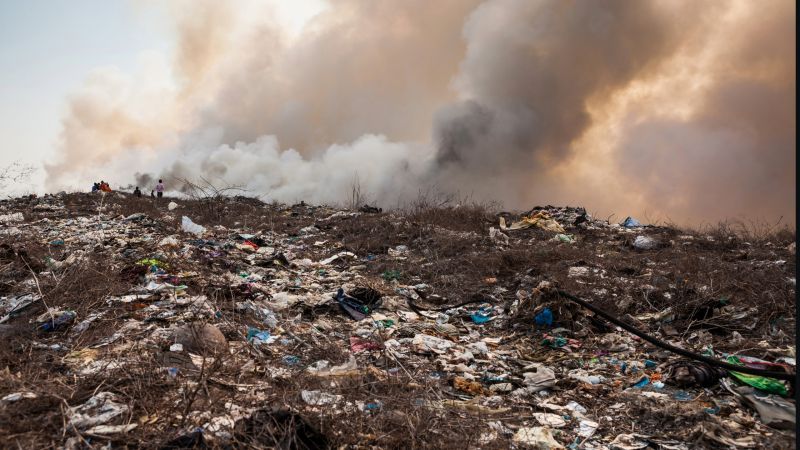Burning Municipal Waste: A Critical Link in Nigeria's Climate and Respiratory Health Crisis
Published on 13 Jan, 2025

With Nigeria ranking 18th on this year's World Population Review list of the most polluted countries on earth, it has become increasingly important that we examine the various practices intensifying environmental pollution in the country. Practices such as the burning of municipal waste, though often overlooked, have propelled the continuous deterioration of our air quality and now pose a major threat to respiratory health - a critical concern that has prompted the launch of the groundbreaking C²REST Nigeria Study (2024-2027).
Why Has This Practice Persisted, and What is Driving it?
In Nigeria today, the open burning of municipal waste has become an all too common disposal method, especially in urban areas. The haze of heavy dark smoke from dump sites ranging from makeshift ones within private properties to larger communal locations like marketplaces, and the massive heaps left on major highways - often awaiting the dry season to be set on fire, has become disturbingly widespread. This is likely due to the perceived convenience and cost-effectiveness associated with it, especially in municipal areas where alternatives like sanitary landfills, recycling, and incineration are inversely perceived as having high logistics and capital demands.
Negligence and lack of awareness undeniably contribute to the widespread adoption of this dangerous practice. Many perceive visible smoke and its immediate effects such as eyes and nose irritation as the only associated risks, not knowing that the invisible and long-term consequences, especially on respiratory health, are far more severe. This knowledge gap is precisely what the C²REST Nigeria Study aims to address through its comprehensive research initiatives, including collecting data on personal exposures to air pollution and linking them with the development of respiratory problems.
What Are Some Public Health Concerns Directly Linked to Burning of Municipal Waste?
Many environmental and public health challenges have been directly associated with the open burning of solid waste. Municipal waste, which primarily consists of plastics, paper, organic material, and other more harmful materials including metals and leather, releases highly hazardous pollutants into the environment when burned. These pollutants include particulate matter (PM2.5 and PM10), dioxins, furans, carbon monoxide, among others, all known for provoking a range of public health crises including:
Poor Air Quality and Increase in Respiratory Illness: According to a 2022 report by Climate Champions, open burning of waste accounts for 29% of fine particulate matter (PM2.5 and PM10) and 11% of global black carbon emission, accounting for over 1.2 million deaths per year in Africa. When municipal waste is burned rather than disposed of using safer processes, the air becomes polluted with vectors that could lead to various respiratory ailments including asthma, chronic obstructive pulmonary disease (COPD), lung cancer, and other lung infections including pneumonia.
Increase in Ground Level Ozone Layer: According to the same report by Climate Champions, open burning of municipal waste directly contributes 5-12% of global greenhouse gas emissions. This increases the concentration of ground-level ozone, which in turn exacerbates respiratory diseases like asthma and bronchitis, and cardiovascular conditions including stroke.
Persistent Organic Pollutants (POPs): The release of dioxins and furans, two of the major persistent organic pollutants into the environment, has been the major public health concern associated with burning municipal waste. In some countries, including Canada, the open burning of waste produces more POPs than all industrial activities combined. Nigeria is not an exception to this, as a 2023 report in the Journal of Hazardous Materials reported widespread dioxin contamination in the country.
Building Resilience Through Research and Community Engagement
The C²REST Nigeria Study, funded by the Medical Research Foundation, UK, represents a critical step forward in addressing these challenges. Through its three-year research initiative, the study aims to not only measure the direct impacts of these environmental hazards on respiratory health but also to understand how communities build resilience against these challenges. By interviewing community members about their knowledge and awareness of climate change and its adverse impacts, the study will help develop more effective, community-driven solutions.
Looking Ahead
The practice of burning municipal waste has far-reaching environmental and public health implications that can no longer be overlooked. With Nigeria climbing the ranks of the world's most polluted countries and respiratory illness becoming increasingly common, the need to address this crisis has become more urgent than ever. The C²REST Nigeria Study's commitment to understanding and addressing these challenges through research, community engagement, and policy advocacy provides hope for meaningful change.
As both individuals and instituted authorities, we can all work towards this by adopting sustainable waste disposal practices such as recycling, closed incineration, and sanitary landfills. Combined with the insights and strategies that will emerge from the C²REST study, these efforts will improve Nigeria's air quality, especially in urban areas, and check the rising spate of respiratory illness while building a more resilient and healthier future for all Nigerians.
